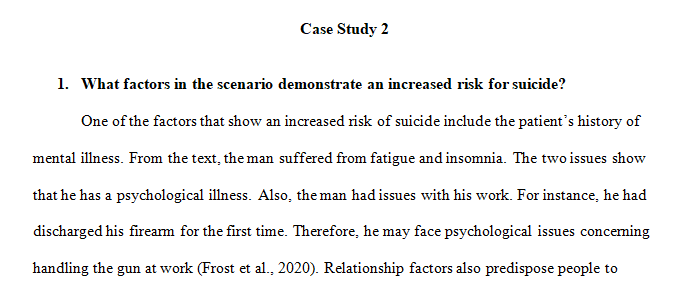Joe, a recently divorced, 56-year-old Caucasian man presents to you, his primary-care provider, with complaints of insomnia
Joe, a recently divorced, 56-year-old Caucasian man presents to you, his primary-care provider, with complaints of insomnia
Hello!
Only need to chose one case
references have to be within the last 5 years. TY so much!
WEEK FOUR CASE STUDY
Week Four Case StudyNUR 603 Week Four Case Study
- Case Study 1
- Rebecca, a 54-year-old woman, was discharged from the emergency department (ED) 3 days ago and is being seen in your office for a follow-up visit. Rebecca is 12 weeks post-hysterectomy and transported herself to the ED with complaints of abdominal pain and chills. Test results from the ED were negative for infection or postsurgical complications. Rebecca was given morphine in the hospital to manage her postsurgical pain and was given a 30-day prescription of Percocet at discharge. When this prescription is exhausted, she now attempts to manage the pain with over-the-counter painkillers (e.g., Tylenol, Advil), but they have been ineffective in managing her pain. The ED health-care provider refused to write another pain management prescription until she could be seen by her primary-care provider. Rebecca noted on today’s intake form that she has trouble sleeping and flu-like symptoms (e.g., muscle pain, bone pain, and chills).
- Case Questions
-
- Assuming that tests performed in the ED ruled out any postsurgical complications or infection, what can be used to help manage pain?
- Given the symptoms reported by Rebecca and the amount of time since her surgery, you suspect that Rebecca may be exhibiting signs of opioid withdrawal. What are the signs of opioid dependence and withdrawal?
- Rebecca’s intake form reveals a number of the symptoms associated with opioid withdrawal. Do these symptoms indicate opioid abuse or dependence?
- What has caused the current epidemic of opioid abuse, and what are the most popular drugs of abuse?
- Why does the pain relief provided by opioids increase the risk of addiction, and what is your responsibility, as the health-care provider, when prescribing opioids?
Case Study 2
- Joe, a recently divorced, 56-year-old Caucasian man presents to you, his primary-care provider, with complaints of insomnia and fatigue. He denies any recent injury or specific pain and was last seen in your office 11 months ago. Joe has taken an antihypertensive medication to control his blood pressure for 3 years and does not report any adverse side effects. Joe has worked in law enforcement for 14 years. He recently discharged his firearm for the first time. Even though no one was injured, Joe has been attending mandated appointments with the department psychologist. Joe reports that he does not have a regular exercise regimen. To relax he typically goes fishing or has a few beers after his shift. Other than the mandated appointments with the department psychologist, Joe has not sought any mental health treatment.
- Case Study Questions
- What factors in the scenario demonstrate an increased risk for suicide?
- What should you include in a suicide risk assessment?
- During the appointment, Joe states that it’s hard for him to talk about how he is feeling and begins to cry. Taking the opportunity to ask Joe about his intentions, what specific questions could you ask?
- You understand that the best predictor of suicide risk is a history of a previous suicide attempt. When asked, Joe admits to placing one of his firearms in his mouth a few times, indicating that the likelihood of Joe attempting suicide is very high. How should you proceed?
- Could Joe benefit from a no-suicide contract?
Requirements: 2 page
Masters Nursing
Answer preview for the paper on ‘Joe, a recently divorced, 56-year-old Caucasian man presents to you, his primary-care provider, with complaints of insomnia’

APA 771 words
Click the purchase button below to download full answer…….
